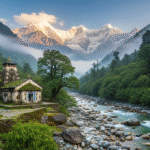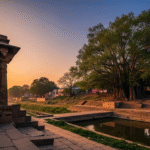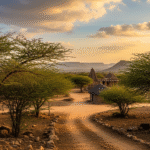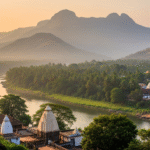Did you know that Majuli Island is in the Brahmaputra River in Assam, India? It is the biggest river island in the world. It covers about 421 square kilometers. This island is not just beautiful. It has a rich history and culture too. Many love its traditions. Yet, the island’s hidden history is truly fascinating.
This article will talk about the mysteries of Majuli Island. We will learn about ancient settlements and the island’s cultural heritage. This will help us see how special Majuli is to Assam. And we will discover amazing stories from its past.
Key Takeaways
- Majuli Island is recognized as the largest river island globally.
- Its hidden past contains numerous cultural narratives.
- The island plays an important role in Assam’s cultural heritage.
- Ancient settlements reveal insights into early inhabitants.
- Understanding Majuli contributes to a broader historical context of the region.
Introduction to Majuli Island
Majuli Island is in the heart of Assam. It is a place of culture and nature. It’s the largest river island in the world, says Guinness World Records. It covers about 421 square kilometers.
The island’s beauty comes from the Brahmaputra River. This has made its landscape stunning. The land and river together support a rich variety of life.
Introduction to Majuli shows its cultural wealth. The island has many satras or monasteries. These are important for spreading the teachings of Vaishnavism. They influence Assamese culture with their music, dance, and art.
Majuli is more than a pretty place. It draws visitors from around the world. People come to see its Majuli Island facts and history. This makes the island a key spot for culture and nature in India.
Geographical Features of Majuli Island
Majuli Island is a special place with unique features. It’s formed by how the Brahmaputra River drops soil and washes it away. The island is mostly flat, which is important for its many plants and animals.
This island has a lot of wet areas covered in green plants. There are many different plants and animals here. This makes it a great home for birds that travel from other places, water creatures, and animals that live only here.
Majuli is also an important part of Assam’s nature. Its beauty draws in people who love nature and those who study it. But, Majuli faces problems like climate change and erosion. Knowing about its lands helps us look after it better.
| Feature | Description |
|---|---|
| Topography | Low-lying land, shaped by riverine processes. |
| Wetlands | Dense wetlands housing diverse ecosystems. |
| Flora | Rich vegetation supporting numerous species. |
| Fauna | Home to endemic wildlife and migratory birds. |
| Climate Vulnerability | Impact of climate change and erosion on ecosystem. |
Majuli Island Facts
Majuli Island is known as the largest river island in the world. It has about 150,000 people living there. The Mishing ethnic community makes up most of the population. These fun facts about Majuli Island show its rich culture and community spirit.
The island’s wildlife is amazing with lots of different plants and animals. This makes Majuli important for saving nature. Its many ecosystems help make it a UNESCO heritage site.
Majuli is famous for its historical sites too. It has over 50 satras, or cultural learning centers. These satras help keep Assamese culture alive, showing deep traditions.
Majuli often faces flooding due to its low land. This makes the area prone to floods. Despite this, the people of Majuli have a strong spirit. They find ways to live with nature’s challenges. This adds a special story to Majuli.
Unknown History of Majuli Island
Majuli Island’s history is full of ancient secrets. It shows how old cultures shape today’s Assamese traditions. This beautiful place helps us understand its own story and why it matters in Assam.
Ancient Settlements and Early Inhabitants
Ancient people lived on Majuli since the 8th century. This turned it into a key spot for Assamese culture to grow. They lived by farming, making clothes, and catching fish. This independent way of life was creative and rich in culture.
Old things found here tell us how these people lived. Their smart ideas and cultural ways can still be seen today.
Role in Assamese Culture and Traditions
Majuli is very important to Assamese traditions. Its satras are places where art, dance, and music have flourished. These places keep old art alive. They also help religious practices stay strong today.
The island’s unknown stories are key to understanding Assamese culture. They show us how old traditions stay alive and meaningful.

Learning about Majuli’s past gives us a bigger view of Assam’s traditions. Discover more about Majuli. See the calm beauty of this special place.
Historical Significance of Majuli
Majuli Island is very important in history. It was a big deal during the Ahom Dynasty. The island had places called satras. These were important for learning and religion. They helped keep the culture alive. They also had a big impact on how people lived and made decisions, showing important historical events in Majuli.
Majuli’s location helped it a lot too. It was on important trade paths. This made its economy strong because of trade. It connected Majuli with far places. This made its culture richer. Despite tough times, Majuli kept its unique ways. This shows how strong and special Majuli is. It adds a lot to the history of Assam.
The satras show how rich Majuli’s heritage is. They carry old traditions and beliefs. Through these places, we see why Majuli Island importance lasts. It mixes history and faith in a special way. This makes Majuli more than just a place. It’s a key part of Assam’s history.
| Aspect | Details |
|---|---|
| Cultural Center | Main hub for learning and spiritual practice during the Ahom Dynasty. |
| Trade Significance | Located along crucial trade routes, enhancing its economic status. |
| Resilience | Preserved unique customs amid historical challenges. |
| Historical Events | Key moments shaped the cultural narrative of Assam. |
| Legacy | Continuing influence on Assamese culture and traditions. |
Majuli Island Origins
The story of Majuli Island is both unique and interesting. It began with the Brahmaputra River, one of the biggest rivers in the world. The river’s sediments built the island over time. Today, Majuli covers about 880 square kilometers. It is the largest river island on the planet.
Formation and Environmental Changes
Majuli has changed a lot because of the Brahmaputra River. On average, the river moves about 22,000 m³/s of water. But during floods, this number can jump to 103,000 m³/s. These changes help form the island’s diverse environments and life.
The floods each year also change the riverbanks. This creates new spots for plants and animals. It shows how nature and the river work together to shape Majuli.
Cultural Evolution Through the Centuries
Majuli’s culture is a mix of many traditions. Over time, people from different backgrounds have come together here. They have created a unique way of life. For example, the Raas Leela festival in November is a big event. It shows the island’s rich cultural arts.
Places like Auniati Satra and Kamalabari Satra keep Assamese culture alive. And in Salmora, people still make pottery the old-fashioned way. All these traditions make Majuli’s culture rich and colorful.

| Features | Details |
|---|---|
| Total Area | 880 square kilometers |
| Average Depth of Brahmaputra | 30 meters (100 ft) |
| Maximum Depth of Brahmaputra | 135 meters (440 ft) |
| Average Discharge | 22,000 m³/s (780,000 cu ft) |
| Flood Discharge | 103,000 m³/s (3,600,000 cu ft) |
| Main Seasons | Summer, Monsoon, Winter |
| Visit Season | October to February |
Untold Stories of Majuli
Majuli Island is a cultural gem in Assam. It’s full of untold stories of Majuli that showcase its rich heritage. These stories are part of local myths, showing the island’s traditions and unique tales. The myths of Assam tell of deities, spirits, and events that impact its people’s lives.
Local Myths and Legends
Majuli’s myths are not just fantasy stories. They are vital to the community’s spirit and culture. Legends talk about powerful gods with their own stories. These myths connect past and present. They keep the wisdom and morals important to Majuli’s tribes like the Mising, Deori, and Sonowal Kachri.
Historical Figures and Their Impact
Srimanta Sankardev is a key figure in Majuli’s history. His teachings deeply influenced Assamese culture. They shaped religion and community feelings. Sankardev’s work still inspires Majuli’s people today. His legacy lives on in their hearts and actions.
Majuli Island Discovery
Majuli Island’s discovery has shown us the importance of this unique land. It is in the Brahmaputra River and is the largest island made by a river. The island’s history shows us different times, especially during the British rule.
When colonizers recorded new places, they noticed Majuli Island. They wrote about its colorful communities and rich nature. This showed how important Majuli was for Assam’s history.
Now, historians and scientists study Majuli’s history deeply. They find things that tell us how people explored the island. This helps us understand how Majuli’s spot on the map affected its culture and growth.
Later research tells us how the island coped with nature’s challenges. These explorations show Majuli’s role is big. It’s not just a piece of land but a key place for culture and nature.
Hidden History of Majuli: Recent Archaeological Findings
Archaeology in Majuli Island has become exciting lately. It shows us much about its history. The island is known for its culture and nature. Now, it tells us about its past. We’ve found old objects that show how people once lived. They found pottery, tools, and parts of buildings. This suggests a lively society existed in Majuli long ago.
These discoveries tell us a lot about Majuli’s secret past. By studying these objects, experts learn about the island’s early days. They look at the social and cultural life back then. Majuli’s story is important for understanding history in the Assam region.
Research on Majuli’s archaeology is getting more attention. Each dig teaches us more about ancient life on the island. Scholars use what they find to explain Majuli’s importance. This includes its role in history and how it connected with other areas.
| Archaeological Findings | Description | Significance |
|---|---|---|
| Pottery | Various ceramic artifacts unearthed from multiple sites. | Reflects daily life and domestic practices of ancient inhabitants. |
| Tools | Stone and metal tools indicating craftsmanship. | Shows technological advancements and skill levels in ancient Majuli. |
| Structures | Remnants of buildings and dwellings. | Provides insight into community organization and living conditions. |
Unexplored Tales of Majuli’s Past
Majuli island is full of unexplored tales of Majuli. They shape its rich culture. These stories are different from history books. They show life through locals’ eyes.
They share personal stories passed down through families. These focus on Majuli’s unique community values and traditions.
These historical narratives of Majuli mix the island people’s memories. They show how Majuli’s people handle changes and hard times. Stories from festivals and how they survive floods make Majuli special.
Local storytellers are key to keeping these stories alive. They share exciting stories about past lives, dreams, and fears. With new changes, saving these stories becomes more important. This makes sure Majuli’s history is remembered.
Majuli’s stories also show how people and nature live together. The Brahmaputra River shapes the island’s culture. Each season brings new stories of hope and struggles. Knowing these stories helps us understand Majuli more deeply.
In short, unexplored tales of Majuli highlight its historical importance. They encourage everyone to learn about Majuli’s past. These stories are inspiring and teach important lessons.
Conclusion
Majuli Island is very special for its long history, culture, and nature. It shows us how people lived a long time ago. It also shows us the beauty of Assam’s culture. Scientists are finding more about it every day. This makes Majuli important for culture today.
Majuli is both beautiful and rich in tradition. We need to protect it for our kids to see. Learning about its past and enjoying its festivals is important. This way, we feel closer to this amazing island. Majuli is more than a place on a map. It connects us to our history.
We must respect Majuli’s history and culture. When we visit, we become part of its story. This helps keep Majuli’s magic alive. Everyone who visits Majuli helps keep its spirit strong. This way, Majuli will always be a special place.
FAQ
What is the historical significance of Majuli Island?
Majuli Island stands as a cultural heart in Assam’s history, especially during the Ahom Dynasty. It influenced how local communities were led. It also played a key role in the economy because of its location.
What are some intriguing facts about Majuli Island?
Known as the biggest river island, Majuli covers about 421 square kilometers. It has around 150,000 people living on it. Most are from the Mishing tribe. The island boasts over 50 satras focusing on cultural learning.
What elements contribute to the unknown history of Majuli Island?
Majuli’s untold stories include ancient settlements from the 8th century. They also cover the early residents’ self-reliant ways. Plus, it significantly influenced Assamese arts and literature through satras.
How has the geography of Majuli Island shaped its culture?
Majuli’s culture comes from its special land and biodiversity. These are shaped by the river’s sedimentation and erosion. This has affected farming, traditional arts, and eco-consciousness among locals.
Are there any myths associated with Majuli Island?
Yes, Majuli has many myths and legends. They often celebrate key historical people like Srimanta Sankardev. These stories show Majuli’s deep spiritual and cultural roots.
What recent archaeological findings have been uncovered on Majuli Island?
Recent digs in Majuli have found things like old pottery, tools, and remains of buildings. These discoveries offer clues about the island’s ancient people.
How did Majuli Island get its name and what are its origins?
“Majuli” comes from “Majuliya,” meaning “land of the Majus” in Assamese. This refers to its early dwellers. The name links to changes in the Brahmaputra River from sediment buildup.
Can you explain the environmental challenges Majuli Island faces?
Majuli faces big risks from climate change and erosion. It’s one of the globe’s most flood-hit zones. Saving its unique nature and heritage is crucial.
What is the role of satras in Majuli’s history?
Satras are key to Majuli’s cultural identity. They’re centers for Vaishnavism. They teach locals about music, dance, and religious practices key to Assamese culture.










